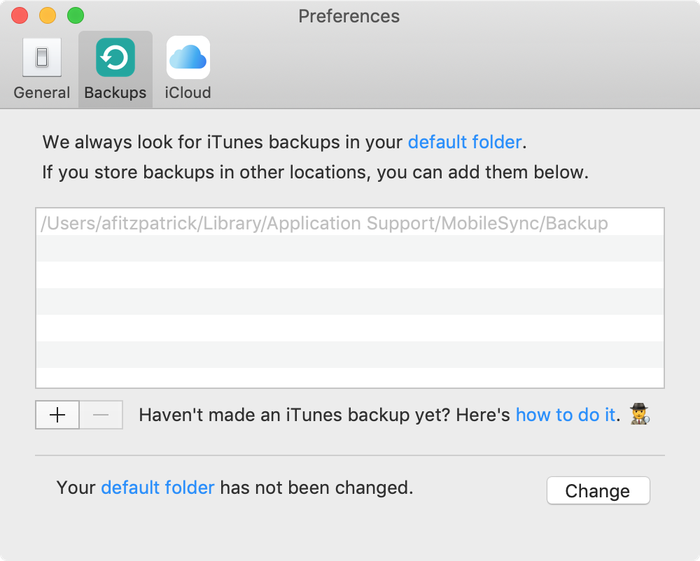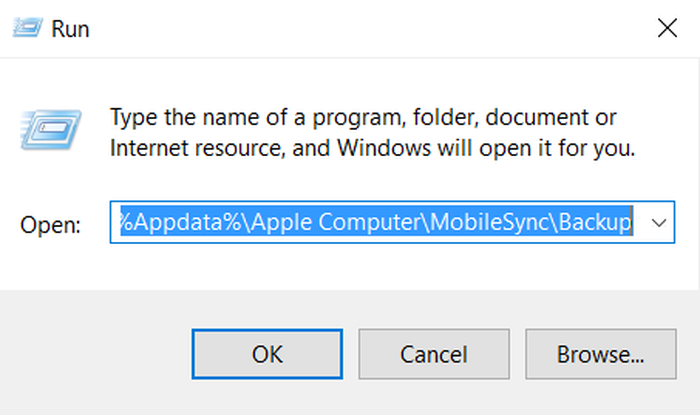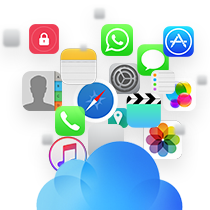Wo werden iPad- und iPhone-Backups auf einem PC oder Mac gespeichert?

Wenn Sie versehentlich Informationen von einem iOS-Gerät gelöscht haben und hoffen, sie wiederherzustellen, kann eine iTunes-Sicherung eine große Hilfe sein.
iTunes-Backups werden automatisch jedes Mal durchgeführt, wenn Sie Ihr iPad oder iPhone mit iTunes verbinden (wenn Sie die Option iCloud Backup nicht aktiviert haben) oder manuell, wenn Sie mit der rechten Maustaste auf das Gerät in iTunes klicken und "Backup" auswählen. Sie werden auf Ihrem Computer gespeichert und enthalten wichtige Daten wie Kontakte, Kurzmitteilungen, Kalender, Notizen, Anrufverlauf und App-Daten.
Wo werden iPhone- oder iPad-Backups gespeichert? Dies hängt davon ab, welches Betriebssystem von Ihrem Computer verwendet wird, obwohl der Standard-Backup-Speicherort für iOS-Versionen identisch ist.
Wo ist der iTunes Backup-Ordner unter Windows?
iTunes-Backups werden in %APPDATA%\Apple Computer\MobileSync unter Windows %APPDATA%\Apple Computer\MobileSync .
Unter Windows 10, 8, 7 oder Vista ist dies ein Pfad wie \Users\[USERNAME]\AppData\Roaming\Apple Computer\MobileSync\Backup .
Unter Windows XP wäre das ähnlich wie \Documents and Settings\[USERNAME]\Application Data\Apple Computer\MobileSync\Backup .
Die Microsoft Store-Version von iTunes unterscheidet sich ein wenig: Sie speichert ihre Backups unter %HOMEPATH%\Apple\MobileSync . Das ist ein Pfad wie \Users\[USERNAME]\Apple\MobileSync\Backup .
Wo befindet sich der iTunes-Sicherungsordner unter macOS / OS X?
iTunes Backups werden in ~/Library/Application Support/MobileSync auf macOS gespeichert.
Dieser Ordner befindet sich normalerweise unter /Users/[USERNAME]/Library/Application Support/MobileSync/Backup .
In macOS 10.15 erstellt Finder anstelle von iTunes iPhone-Backups. Diese Sicherungen werden jedoch am selben Speicherort gespeichert.
So finden Sie den iTunes-Sicherungsordner automatisch
Der iPhone-Sicherungs-Extraktor sucht automatisch den iTunes-Sicherungsordner und kann ihn mit einem Klick öffnen. Diese Funktionalität ist in der kostenlosen Version enthalten, so dass dies nichts kostet.
- Laden Sie den iPhone Backup Extractor herunter und installieren Sie ihn
- Öffnen Sie das
Preferencesaus dem Pulldown-Menü der App - Wählen Sie die Registerkarte
Backups. - Klicken Sie auf den Link "Standardordner", wenn im Fenster die Meldung "Wir suchen immer in Ihrem Standardordner nach Sicherungen" suchen. Einfach!

Öffnen des iTunes Backup-Ordners unter Windows
Öffnen Sie den Standardspeicherort in Explorer mit dem Windows-Befehl "Ausführen". ⊞ Win + R und das Run-Fenster sollte erscheinen. Geben Sie %APPDATA%\Apple Computer\MobileSync und drücken ⏎ Enter .
Für die Microsoft Store-Version von iTunes können Sie dies tun: ⊞ Win + R und das Fenster "Ausführen" sollte ⊞ Win werden. Geben Sie %HOMEPATH%\Apple\MobileSync und drücken Sie ⏎ Enter .
So sieht das unter Windows 10 aus:

Das sich öffnende Explorer-Fenster zeigt einen Ordner namens "Backup" an. Dies enthält alle iTunes-Backups, die bereits auf dem Computer vorhanden sind.
Den iTunes Backup-Ordner auf Mac OS finden
Der Standard-Backup-Speicherort kann im Finder mit Spotlight angezeigt werden. Drücken von ⌘ Cmd + und geben Sie ~/Library/Application Support/MobileSync bevor Sie ⏎ Enter .
Das Finder-Fenster, das geöffnet wird, zeigt einen Ordner namens "Backup". Dies enthält alle iTunes-Backups, die bereits auf dem Computer vorhanden sind.
Ändern des Speicherortes des iTunes Backup-Ordners
Wenn Sie den Ordner ändern möchten, in dem iTunes standardmäßig Sicherungskopien erstellt, finden Sie in unserem Support-Center eine praktische Anleitung .


von Sohaib Ahmed
Thanks alot.
Cheers.. .. .!!!
von Jake Lown
Hi, I would like to restore a previous backup but I'm having trouble finding out my backup password. Can you please help me with this?
antworten Sie mit: Reincubate Support
Hey Jake, we've got a guide on password recovery. You can find it here.
von Gerry Wood
Many thanks for enabling me to find the backup file for my iphone on my PC. When I click on the properties of the backup file it shows that I have 2.23gb backed up in 3503 files which is reassuring.
If I now wish to view the contacts that have been backed up or restore them to a different device how do I do that if I've replaced my iphone with an android phone?
antworten Sie mit: Reincubate Support
Hi Gerry, thanks for asking. We're glad the article was helpful. If you install iPhone Backup Extractor, you'll see the free edition lets you browse through all of your contacts. Try that — it can export your contacts into a
VCFformat that your Android will easily be able to import.von Apple Repair New Orleans
I plan to buy an iPhone 6S Plus from a client, but they want me to transfer all their data to their old 5C. I backed it up in iTunes, then plugged in the 5C, but the 6s backup is nowhere to be seen from the drop down list!
The 5C is 32GB and the 6S Plus is only 16GB, so I don't know what the problem is. Any ideas?
antworten Sie mit: Reincubate Support
Hi guys, thanks for commenting. This one's an old chestnut: it's caused by one of the phones running a different version of iOS to the backup. Upgrade one or other so that they're running the same version, then update the backup. That'll sort it out!
von Justin
First of all; Thanks for the easy and helpful steps to get this far in the process. I am just curious as I am copying my backup off of my pc if it just as simple as me copying this backup off of my (non internet accessible) pc onto a hard drive, then I can drag and drop into the list of backups on the new Mac. I am trying to restore my old backup onto my new iPhone six, but my pc has lost ability to connect to the Internet, so I can't download the new iTunes update to be able to work with my iPhone six.
antworten Sie mit: Reincubate Support
Justin! Thanks for writing. Yes, it really is that easy. You can move iTunes backup folders between Macs, or even between Macs and PCs.
von Brian Corbett
You have confirmed to me the preposterous nature of the iPad backup system. Why can't they use files like windows?
antworten Sie mit: Reincubate Support
Hi Brian, the iOS device does all the work when making a backup and simply relays the data to the PC or Mac (or to iCloud). They use this format partly to make it straightforward (and fast!) for the device, but also to discourage inadvertent modification of files, and to easily be able to layer encryption on top. It works pretty well in most cases!
von Chris
i found the backup files but they look coded in jibberish. how can i read them as they would appear from my phone, opposed to being random numbers and letters? please halp
antworten Sie mit: Reincubate Support
Hi Chris, that's what iPhone Backup Extractor does. Load up the free version, and choose "Expert mode". That'll show you the structure the files decode to. ?
von Bennie
My iphone and ipad was backed on the same computer, will it be a separate folder or combine on the same folder?
antworten Sie mit: Reincubate Support
Hi Bennie, they'll be in separate folders, both in the master
Backupsfolder. Each folder will be named after the phone's UDID, which is a long phrase name of letters and numbers.von Mosin
How do i get the contacts from the folder on to a android? could you please let me know as soon as possible please
antworten Sie mit: Reincubate Support
Hi Mosin, thanks for commenting! We've got a guide that takes you through transferring contacts to Android here.
von sf
would u also tell me how do i get there..
i mean where i can find Users\USERNAME\AppData\Roaming\Apple Computer\MobileSync\Backup
as i am using windows 7
antworten Sie mit: Reincubate Support
Hi sf: sure! We've updated the article to make it clearer that Windows backups are stored under a different location. Does that help?